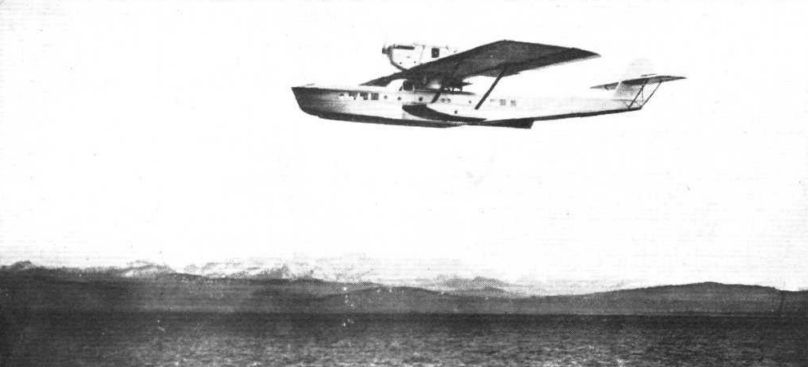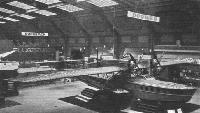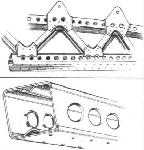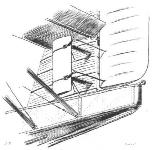
Dornier Do J, Do R, Do 15 Wal и Super Wal
<...>
Помимо обычных Wal, был создан вариант Do-R Super Wal, выпускавшийся в Фридрихсхафене, первый прототип которого Do R2 взлетел в сентябре 1926 года. Отличавшийся крылом увеличенного размаха и удлиненным корпусом, Super Wal имел две кабины, вмещавшие 19 пассажиров, и обслуживался экипажем из четырех человек. По конструкции Do R2 был подобен обычному Wal, а его силовая установка состояла из пары двигателем Rolls-Royce Condor мощностью 650 л. с. (485 кВт). Но на Do R4, построенный в 1927 году, установили две пары радиальных двигателей Bristol Jupiter, что позволило увеличить взлетную массу и максимальную скорость машины на 33% и 16% соответственно. Super Wal строился по лицензии в нескольких странах и использовался разными авиакомпаниями, включая, конечно, и "Deutsche Luft Hansa". В 1934 году самолеты семейства Wal получили обозначение Do 15.
Описание:
- Dornier Do J, Do R, Do 15 Wal и Super Wal
- Flight, January 1928
THE NEW DORNIER "SUPER-WAL” - Flight, October 1928
Berlin Aero Show 1928
Фотографии
-
Flight 1926-11 / Flight
A 1,300-H.P. FLYING BOAT: This photograph shows the new Dornier "Super-Wal," fitted with two Rolls-Royce "Condor" engines, in flight over Lake Constance, where it recently underwent its first flying tests. This machine has seating accommodation for 21 passengers in two separate cabins. An idea of the size of the machine may be formed when it is pointed out that the wing span is 28-5 m. (93 ft. 6 in.) and the wing area 143 sq. m. (1,540 sq. ft.).
-
Aeroplane Monthly 1989-07 / J.Stroud - Wings of Peace
Unidentified R 2 Superwal, possibly with Packard engines.
-
Aeroplane Monthly 1989-07 / J.Stroud - Wings of Peace
THE DORNIER SUPER-WAL: This Dornier all-metal flying-boat, which is fitted with two Rolls-Royce "Condor" engines of 650 h.p. each, recently carried out some remarkable flights over Lake Constance, on one occasion carrying 55 passengers at 125 m.p.h. Our picture shows the machine in flight over Lake Constance.
The prototype Do R 2 Superwal on the step. -
Aeroplane Monthly 1989-07 / J.Stroud - Wings of Peace
This view of the Do R 2 shows the offset cockpit.
-
Aeroplane Monthly 1989-07 / J.Stroud - Wings of Peace
Регистрационный номер: D-1115 D-1115 was the first Superwal. Powered by two Rolls-Royce Condors, it was designated Do R bis. It is seen here at Friedrichshafen with the Wal G-EBQO in the background.
Другие самолёты на фотографии: Dornier Do.J Wal - Германия - 1922
-
Aeroplane Monthly 1989-07 / J.Stroud - Wings of Peace
This view of the prototype Superwal again shows the type's offset cockpit, together with the installation of the Rolls-Royce Condors, and the external stiffeners on the hull.
-
Aeroplane Monthly 1989-07 / J.Stroud - Wings of Peace
Регистрационный номер: D-1337 [2] The Superwal Do R Nas before receiving its registration D-1337.
A NEW DORNIER SUPER-WAL: Our picture shows a new all-metal Super-Wal flying-boat, fitted with four British Napier "Lion" engines, which recently carried out successful flying tests over Lake Constance. In addition to 20 passengers, this machine carries a crew of three, and with a full load of 12 tons it has a top speed of 125 m.p.h.; it has a cruising speed of over 105 m.p.h. -
Aeroplane Monthly 1989-07 / J.Stroud - Wings of Peace
Регистрационный номер: D-1337 [2] D-1337, Luft Hansa’s Do R Nas Pottwal, with Napier Lions.
-
Мировая Авиация 56
Dornier Super Wal - увеличенный вариант Wal с более мощной силовой установкой и повышенной грузоподъемностью - заходит на посадку на фоне пролетающего дирижабля Zeppelin.
-
Aviation Historian 31 / M.Wickstead - Italy's forgotten airlines (1)
Регистрационный номер: I-REOS "GRAF ZEPPELIN": The new Zeppelin airship L.Z.127, which has just accomplished a record flight from Germany to Lakehurst, N.J., flying over Lake Constance during her trials. In the foreground is a Dornier "Super-Wal" (four Bristol "Jupiters") flying boat.
Powered by four Gnome-Rhone-built Jupiter engines in paired tandem configuration, Dornier Super Wal I-REOS (c/n 144) was one of six operated by SANA from October 1928 and served with the airline until it was destroyed in May 1934. The other SANA Super Wals were I-RATA (c/n 145), I-RENE (c/n 141), I-RIDE (c/n 142), I-RONY (c/n 170) and I-RUDO (c/n 171). -
Мировая Авиация 56
Do R4 Super Wal отличался от предшественников возросшей скоростью и грузоподъемностью. За время производства этих самолетов сменили четыре типа крыла, постоянно увеличивающихся в размахе, а максимальная взлетная масса машины выросла с 4000 до 10 000 кг.
-
Aeroplane Monthly 1989-07 / J.Stroud - Wings of Peace
Регистрационный номер: I-RONY Superwal I-RONY in service with SANA.
-
Aviation Historian 31 / M.Wickstead - Italy's forgotten airlines (1)
Регистрационный номер: I-RENE [4] Super Wal I-RENE was one of the first two delivered to SANA in late 1928, and operated with the company until it was withdrawn from use in June 1930. The Super Wal was a larger version of the Wal, with a 93ft 6in (28-5m) - span wing of metal two-spar structure with a smooth duralumin leading edge and fabric-covered trailing edge.
-
Aeroplane Monthly 1989-07 / J.Stroud - Wings of Peace
Регистрационный номер: I-RENE [4] This view of I-RENE clearly shows the engine layout, metal-covered centre section and the hull decking stiffeners.
-
Aeroplane Monthly 1989-07 / J.Stroud - Wings of Peace
Регистрационный номер: I-RENE [4] I-RENE was the first four-engined Superwal.
-
Flight 1928-01 / Flight
Регистрационный номер: I-RENE [4] A MERE BAGATELLE: Two views of the new Dornier "Super-Wal" flying-boat, which is fitted with four "Jupiter" engines, It has a wing span of 93 ft. 10 in., and a wing area of 1,539 sq. ft. Note the tandem arrangement of the wings.
-
Aeroplane Monthly 1989-07 / J.Stroud - Wings of Peace
Регистрационный номер: I-RIDE SANA's Superwal I-RIDE.
-
Flight 1928-10 / Flight
Регистрационный номер: D-1500 [3] The Dornier "Super-Wal": The power plant consists of four "Jupiters."
-
Flight 1928-10 / Flight
Регистрационный номер: D-1500 [3] The Dornier Super-Wal "Blauwal": This photograph shows the cowling of the aft engines, the shape of the wing-stump floats, and the narrow-beam aft step with water rudder.
-
Aeroplane Monthly 1989-07 / J.Stroud - Wings of Peace
The front cabin of a Superwal I.
-
Aeroplane Monthly 1989-07 / J.Stroud - Wings of Peace
Регистрационный номер: D-1500 [3] KEITH WOODCOCK’S painting shows Dornier Superwal D-1500 Blauwal (Blue Whale) with Gnome-Rhone Jupiter engines.
-
Flight 1928-10 / Flight
THE DORNIER "SUPER WAL": Sketches showing forms of Dornier metal wing-spar construction.
-
Flight 1928-10 / Flight
AN UNUSUAL FORM OF RUDDER BALANCE: On the Dornier "Super-Wal" separate surfaces, unstably hinged, are made to facilitate the work of operating the rudder.
- Фотографии






















